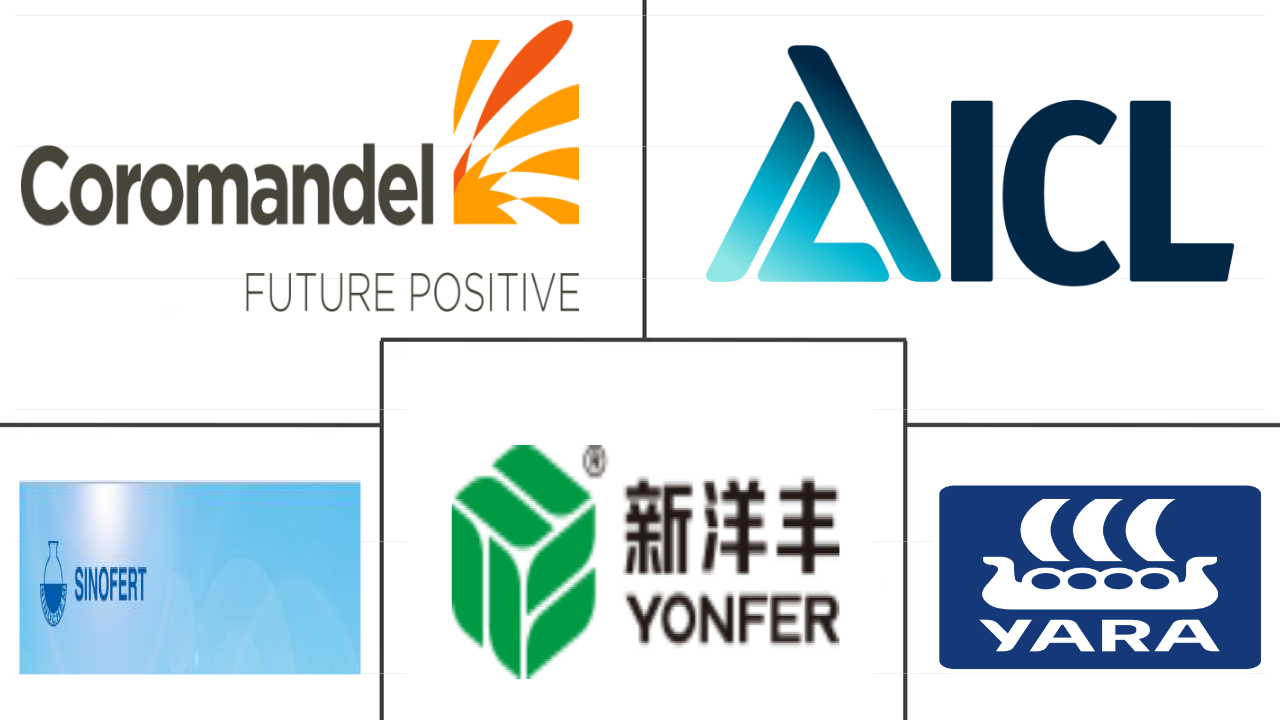Market Size of asia-pacific fertilizers Industry
|
|
Study Period | 2017 - 2030 |
|
|
Market Size (2024) | USD 167.2 Billion |
|
|
Market Size (2030) | USD 240.5 Billion |
|
|
Largest Share by Crop Type | Field Crops |
|
|
CAGR (2024 - 2030) | 6.24 % |
|
|
Largest Share by Country | China |
Major Players |
||

|
||
|
*Disclaimer: Major Players sorted in no particular order |
Asia-Pacific Fertilizers Market Analysis
The Asia-Pacific Fertilizers Market size is estimated at 167.2 billion USD in 2024, and is expected to reach 240.5 billion USD by 2030, growing at a CAGR of 6.24% during the forecast period (2024-2030).
167.2 Billion
Market Size in 2024 (USD)
240.5 Billion
Market Size in 2030 (USD)
6.69 %
CAGR (2017-2023)
6.24 %
CAGR (2024-2030)
Largest segment by Product
51.47 %
value share, Urea, 2023
Given the region's heavy reliance on agriculture, countries are bolstering the sector through diversification and multi-cropping initiatives, potentially driving up urea demand.
Largest Segment by Crop Type
81.97 %
value share, Field Crops, 2023
Field crops dominated in fertilizers consumption because they are grown intensively, depleting soil nutrients and necessitating the use of more fertilizers to compensate.
Fastest Growing Speciality Type
7.17 %
Projected CAGR, CRF, 2024-2030
The region's increasing emphasis on ecologically safe fertilizers is a key driver behind the surge in demand for new controlled-release options.
Largest segment by Country
33.47 %
value share, China, 2023
Large area under cultivation, a growing population, and the need for food and nutritional security may drive the fertilizer market in China during the forecast period.
Leading Market Player
1.65 %
market share, Sinofert Holdings Limited, 2022

Sinofert has emerged as a market leader by developing about 60 types of compound and mixed fertilizers according to different climates, soils, and planting practices.
Intensive cultivation and soil nutrient depletion increase fertilizer consumption
- The Asia-Pacific fertilizer market is dominated by field crops, which make up around 81.5% of the overall fertilizer market. Field crop production accounts for more than 90.0% of the region's total agricultural land. The major field crops produced in the region are rice, wheat, soybean, rapeseed/canola, and cotton. Generally, field crops consume the most nitrogen fertilizers. Because grains and cereals are grown intensively, they deplete soil nutrients, necessitating the use of more fertilizers to compensate.
- In 2022, horticultural crops constituted 17.9% of the region's fertilizer market value. China and India command over 70.0% of the horticultural crop production area in the region. The rising demand for fresh fruits and vegetables, coupled with efforts to meet this demand, is poised to propel the horticultural crop market.
- China and India, with their abundant arable land and sizable populations, stand out as key agricultural players in the Asia-Pacific. The government's significant financial support for agricultural mechanization and productivity enhancement further bolsters this growth trajectory.
- The region has witnessed a notable uptick in cultivation area, with a 10.5 million ha expansion from 2017 to 2022. Agriculture employs a fifth of the region's population and occupies more than half of its land, making it a vital contributor to the Asia-Pacific economy. The imperative to enhance food security, coupled with evolving climatic conditions and soil nutrient challenges, is poised to fuel the fertilizer market in the region.
The growing population's need for higher food production and productivity may drive the market
- According to the USDA, China, the world's largest fertilizer producer and exporter, accounted for 25% of global fertilizer production. In 2022, the Chinese fertilizer market was valued at USD 70.3 billion, with a consumption of 94.2 million metric tons.
- India, the world's second-largest fertilizer consumer, consumed 81.4 million metric tons in 2022. Despite being the third-largest global producer, India relies on imports for 25% of its urea, 55% of its phosphorus, and 100% of its potash annually.
- The Indonesian agricultural sector has been experiencing a considerable expansion, which has led to an increase in arable land. This, in turn, has boosted the country's agricultural production, making it an essential player in the region's agricultural industry. As a result, Indonesia has become the third-largest consumer in terms of market value and volume consumption, accounting for 5.6% of the value and 6.7% of volume in the region.
- In 2022, Pakistan held a 4.2% share in the Asia-Pacific fertilizer market. Field crops dominated fertilizer consumption, accounting for 86.3% of the volume, followed by horticultural crops at 13.5% and turf & ornamental crops at a negligible 0.1%. This trend can be attributed to the larger land area dedicated to field crops.
- The market is expected to be driven by factors such as the growing population's need for higher food production and productivity, especially since the area available for cultivation is decreasing. Additionally, the adoption of advanced cultivation methods will increase the usage of both conventional and specialty fertilizers.
Asia-Pacific Fertilizers Industry Segmentation
Complex, Straight are covered as segments by Type. Conventional, Speciality are covered as segments by Form. Fertigation, Foliar, Soil are covered as segments by Application Mode. Field Crops, Horticultural Crops, Turf & Ornamental are covered as segments by Crop Type. Australia, Bangladesh, China, India, Indonesia, Japan, Pakistan, Philippines, Thailand, Vietnam are covered as segments by Country.
- The Asia-Pacific fertilizer market is dominated by field crops, which make up around 81.5% of the overall fertilizer market. Field crop production accounts for more than 90.0% of the region's total agricultural land. The major field crops produced in the region are rice, wheat, soybean, rapeseed/canola, and cotton. Generally, field crops consume the most nitrogen fertilizers. Because grains and cereals are grown intensively, they deplete soil nutrients, necessitating the use of more fertilizers to compensate.
- In 2022, horticultural crops constituted 17.9% of the region's fertilizer market value. China and India command over 70.0% of the horticultural crop production area in the region. The rising demand for fresh fruits and vegetables, coupled with efforts to meet this demand, is poised to propel the horticultural crop market.
- China and India, with their abundant arable land and sizable populations, stand out as key agricultural players in the Asia-Pacific. The government's significant financial support for agricultural mechanization and productivity enhancement further bolsters this growth trajectory.
- The region has witnessed a notable uptick in cultivation area, with a 10.5 million ha expansion from 2017 to 2022. Agriculture employs a fifth of the region's population and occupies more than half of its land, making it a vital contributor to the Asia-Pacific economy. The imperative to enhance food security, coupled with evolving climatic conditions and soil nutrient challenges, is poised to fuel the fertilizer market in the region.
| Type | ||||||||||||||||||||||||||||||||||
| Complex | ||||||||||||||||||||||||||||||||||
|
| Form | ||||||
| Conventional | ||||||
|
| Application Mode | |
| Fertigation | |
| Foliar | |
| Soil |
| Crop Type | |
| Field Crops | |
| Horticultural Crops | |
| Turf & Ornamental |
| Country | |
| Australia | |
| Bangladesh | |
| China | |
| India | |
| Indonesia | |
| Japan | |
| Pakistan | |
| Philippines | |
| Thailand | |
| Vietnam | |
| Rest of Asia-Pacific |
Asia-Pacific Fertilizers Market Size Summary
The Asia-Pacific fertilizers market is experiencing significant growth, driven by the region's extensive agricultural activities, particularly in field crops such as rice, wheat, and cotton. These crops dominate the agricultural landscape, necessitating substantial fertilizer use to replenish soil nutrients depleted by intensive cultivation. The market is further bolstered by the rising demand for horticultural crops, especially in China and India, where efforts to meet the increasing need for fresh produce are expanding the cultivation area. The region's agricultural sector, supported by government initiatives and financial backing, plays a crucial role in the economy, with a focus on enhancing food security amid evolving climatic conditions and soil nutrient challenges.
China and India are pivotal players in the Asia-Pacific fertilizers market, with China being the largest global producer and exporter of fertilizers. The region's demand for primary nutrients, particularly nitrogen and potassium, is high due to prevalent soil deficiencies. The market is characterized by a shift towards highly efficient fertilizers to mitigate environmental concerns related to nutrient runoff. Despite the fragmented nature of the market, with major companies like Coromandel International Ltd. and Yara International ASA holding significant shares, strategic partnerships and product innovations are shaping the competitive landscape. The expansion of arable land and the adoption of advanced cultivation methods are expected to further drive fertilizer consumption in the coming years.
Asia-Pacific Fertilizers Market Size - Table of Contents
-
1. MARKET SEGMENTATION (includes market size in Value in USD and Volume, Forecasts up to 2030 and analysis of growth prospects)
-
1.1 Type
-
1.1.1 Complex
-
1.1.2 Straight
-
1.1.2.1 Micronutrients
-
1.1.2.1.1 Boron
-
1.1.2.1.2 Copper
-
1.1.2.1.3 Iron
-
1.1.2.1.4 Manganese
-
1.1.2.1.5 Molybdenum
-
1.1.2.1.6 Zinc
-
1.1.2.1.7 Others
-
-
1.1.2.2 Nitrogenous
-
1.1.2.2.1 Ammonium Nitrate
-
1.1.2.2.2 Anhydrous Ammonia
-
1.1.2.2.3 Urea
-
1.1.2.2.4 Others
-
-
1.1.2.3 Phosphatic
-
1.1.2.3.1 DAP
-
1.1.2.3.2 MAP
-
1.1.2.3.3 SSP
-
1.1.2.3.4 TSP
-
1.1.2.3.5 Others
-
-
1.1.2.4 Potassic
-
1.1.2.4.1 MoP
-
1.1.2.4.2 SoP
-
1.1.2.4.3 Others
-
-
1.1.2.5 Secondary Macronutrients
-
1.1.2.5.1 Calcium
-
1.1.2.5.2 Magnesium
-
1.1.2.5.3 Sulfur
-
-
-
-
1.2 Form
-
1.2.1 Conventional
-
1.2.2 Speciality
-
1.2.2.1 CRF
-
1.2.2.2 Liquid Fertilizer
-
1.2.2.3 SRF
-
1.2.2.4 Water Soluble
-
-
-
1.3 Application Mode
-
1.3.1 Fertigation
-
1.3.2 Foliar
-
1.3.3 Soil
-
-
1.4 Crop Type
-
1.4.1 Field Crops
-
1.4.2 Horticultural Crops
-
1.4.3 Turf & Ornamental
-
-
1.5 Country
-
1.5.1 Australia
-
1.5.2 Bangladesh
-
1.5.3 China
-
1.5.4 India
-
1.5.5 Indonesia
-
1.5.6 Japan
-
1.5.7 Pakistan
-
1.5.8 Philippines
-
1.5.9 Thailand
-
1.5.10 Vietnam
-
1.5.11 Rest of Asia-Pacific
-
-
Asia-Pacific Fertilizers Market Size FAQs
How big is the Asia-Pacific Fertilizers Market?
The Asia-Pacific Fertilizers Market size is expected to reach USD 167.23 billion in 2024 and grow at a CAGR of 6.24% to reach USD 240.52 billion by 2030.
What is the current Asia-Pacific Fertilizers Market size?
In 2024, the Asia-Pacific Fertilizers Market size is expected to reach USD 167.23 billion.

